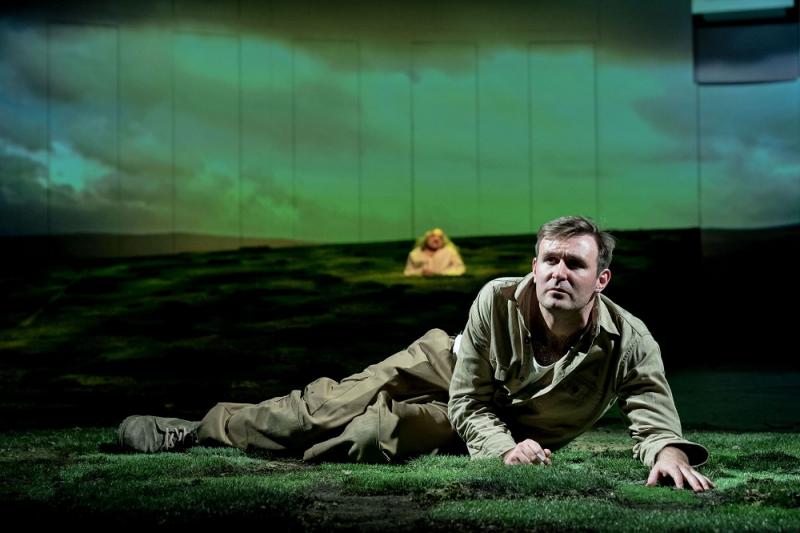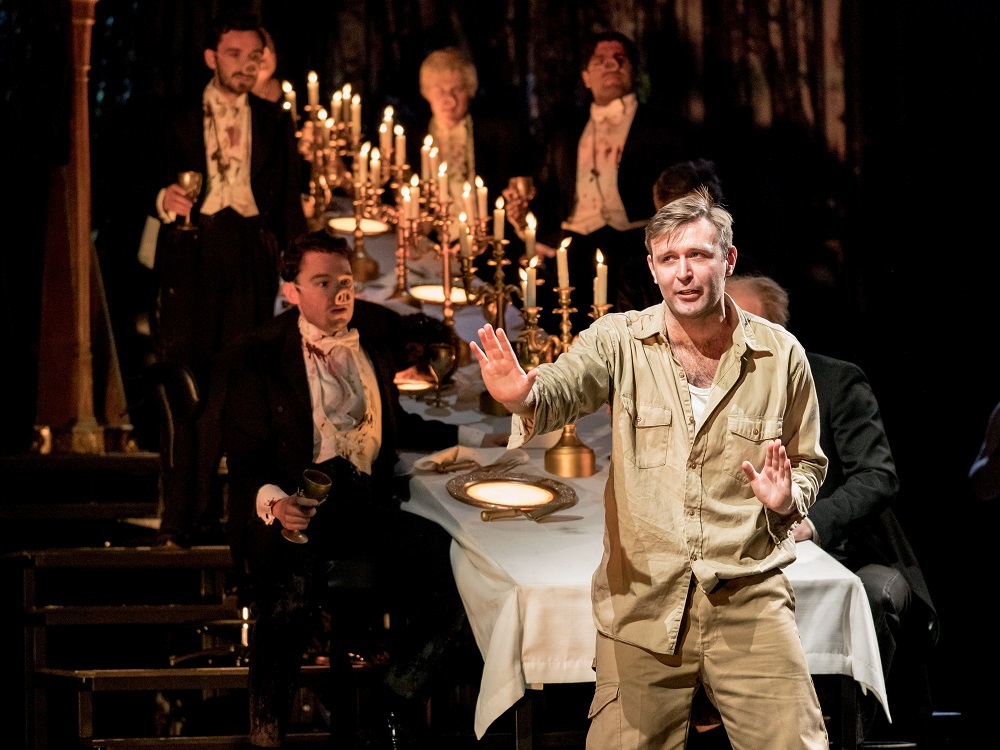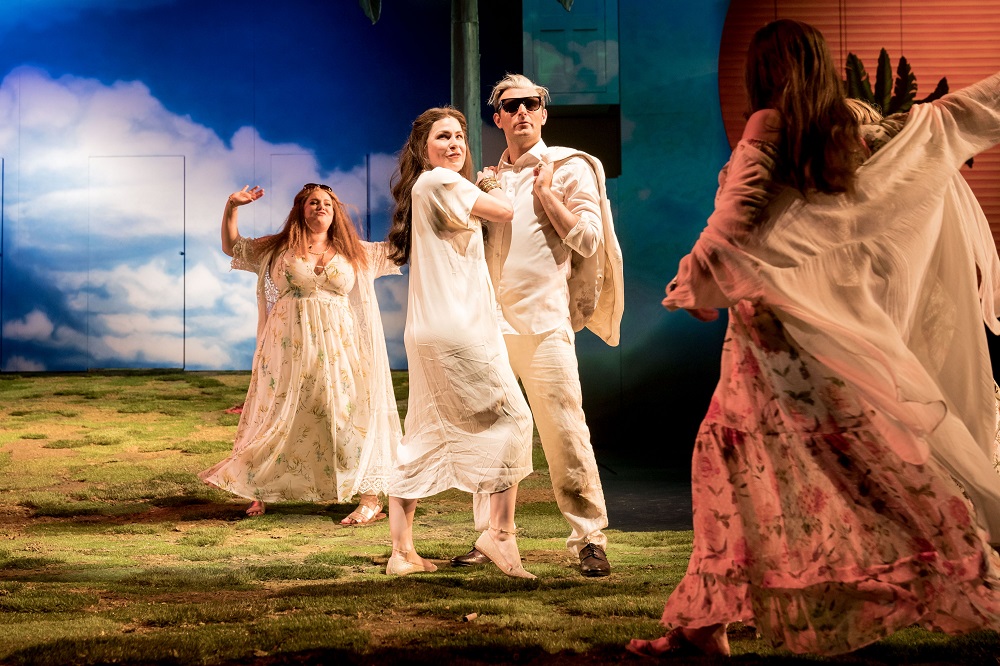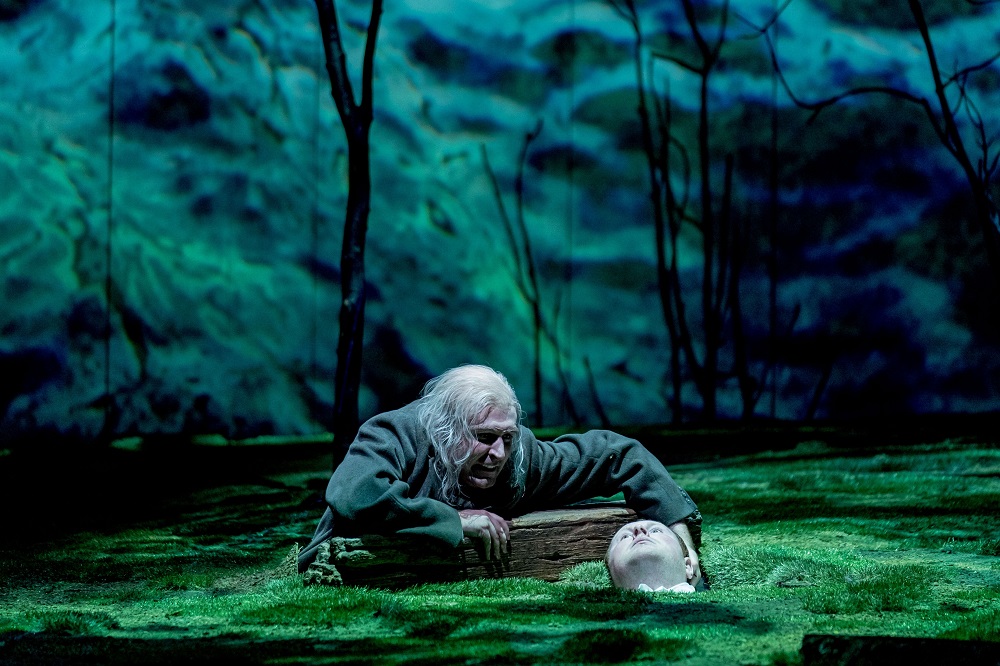Peter Gynt, National Theatre review - towering protagonist, middle-way production | reviews, news & interviews
Peter Gynt, National Theatre review - towering protagonist, middle-way production
Peter Gynt, National Theatre review - towering protagonist, middle-way production
James McArdle's lead, strong ensemble and David Hare's Ibsen adaptation compel

Like Hamlet and both parts of Goethe's Faust, with which it shares the highest peak of poetic drama, Ibsen's Peer Gynt is very long, timeless en
Yet despite its often literal-minded hits and misses, it’s baffling how anyone could be bored during the three-hour playing time when McArdle holds the stage throughout. He achieves the difficulty of making the swaggerer we first meet sympathetic very quickly, despite being what Peter’s mother Agatha (believably played by Anne Louise Ross as a self-educated Scot living in a wee bungalow who loves her Ali Smith and Richard Strauss) describes as "a serial fantasist with attention deficit disorder" and a lack of empathy – one who will go on to try and find out what “to thine own self be true” means, without much success. His plundering of old war movie narratives – The Guns of Navarone, The Dambusters – is amusing, his confidences to the audience charismatic and always engaging.  McArdle makes us scared for Peter’s discoveries in the Hall of the Mountain King (Jonathan Coy), even if these Bullingdon Trolls with pig snouts aren’t threatening enough (though Nabil Shaban as the Nothingness that is the Boyg has the right strangeness, even if this is not Ibsen’s “Voice in the Dark”) Peter's heaven’s-gate narrative to his dying mother is deeply moving, as it should be, his Act Two (Four in the drama) transformation into a self-styled “hyphenate businessman-philosopher” with his own adjective (Gyntian) preaching to a dodgy Frenchman, Icelandic banker and a Russian whose kind he praises for “a happy-go-lucky attitude to the sanctity of human life” believable. If it's poetic licence to think of McArdle's character as 70 years old at the end, at least we keep company with the same actor; tradition has been to split the protagonist between two performers.
McArdle makes us scared for Peter’s discoveries in the Hall of the Mountain King (Jonathan Coy), even if these Bullingdon Trolls with pig snouts aren’t threatening enough (though Nabil Shaban as the Nothingness that is the Boyg has the right strangeness, even if this is not Ibsen’s “Voice in the Dark”) Peter's heaven’s-gate narrative to his dying mother is deeply moving, as it should be, his Act Two (Four in the drama) transformation into a self-styled “hyphenate businessman-philosopher” with his own adjective (Gyntian) preaching to a dodgy Frenchman, Icelandic banker and a Russian whose kind he praises for “a happy-go-lucky attitude to the sanctity of human life” believable. If it's poetic licence to think of McArdle's character as 70 years old at the end, at least we keep company with the same actor; tradition has been to split the protagonist between two performers.
Kent may be right to turn the central wanderings into a kind of comic cabaret, with Anitra and her chums con-artists posing as new-age Americans (pictured below, McArdle with Tamsin Carroll as Anitra and Lauren Ellis-Steele) – a neat parallel to the cowgirl trio Hare makes of Ibsen’s wild mountain pasturers – but there needs to be more strangeness as the travelogue progress, in both the encounter with the Sphinx and the Cairene madhouse where the man who would be King of Self is crowned by multiple lookalikes.  The brief interlude whisking us back to the faithful Sabine (originally Solveig) in Scotland is cringeworthy, featuring a naff song which is all too typical of Paul Englishby’s soft-focus score (the pop pastiches are fine). Grieg’s original incidental music in its entirety is far more unsettling; although we rarely get it today, Solveig’s Song has been hauntingly engaged in unaccompanied form in both Baltasar Kormákur's mortuary-set National Theatre of Iceland and Irina Brook’s productions. As with the latter and the stunning Norwegian National Theatre TV-studio spectacle, where Solveig was played by Nigerian-Norwegian singer-songwriter Amina Sewali, Hare makes her a refugee, but there is nothing “other” about Anya Chalotra’s very English delivery.
The brief interlude whisking us back to the faithful Sabine (originally Solveig) in Scotland is cringeworthy, featuring a naff song which is all too typical of Paul Englishby’s soft-focus score (the pop pastiches are fine). Grieg’s original incidental music in its entirety is far more unsettling; although we rarely get it today, Solveig’s Song has been hauntingly engaged in unaccompanied form in both Baltasar Kormákur's mortuary-set National Theatre of Iceland and Irina Brook’s productions. As with the latter and the stunning Norwegian National Theatre TV-studio spectacle, where Solveig was played by Nigerian-Norwegian singer-songwriter Amina Sewali, Hare makes her a refugee, but there is nothing “other” about Anya Chalotra’s very English delivery.
At least Peter’s final return to the waiting woman is done with poetic restraint – the lullaby this time for solo voice only – and there are good ideas in the spooky endgame of the last act; Hare adds to the undone deeds and words articulated by natural phenomena the ghosts of Peter’s past, and gets in some well-timed humour (I laughed throughout a lot). But shouldn’t this all be in a dying or delirious Peter’s mind? No matter; the acting, as throughout, carries it, with a chillingly matter of fact late appearance from the great Oliver Ford Davies as the Button Moulder and a laid-back devil disguised as Weird Passanger and Priest from Guy Henry.  Richard Hudson’s designs give us a sense of the northern outdoors - the Olivier is the right venue, too - and are put to ingenious use alongside Dick Straker’s video work in the homecoming (pictured above: McArdle and Marc Mackinnon as Ship's Cook). But Kent could have made it all so much more imaginative. What Peer Gynt needs is a visionary transformation like that of Simon Stone, whose The Wild Duck remains the most powerful Ibsen re-think I've ever seen in the theatre, excellent Icelandic and Norwegian Peer Gynts notwithstanding. So this production goes neither to heaven nor hell but into the Button Moulder’s ladle; not so its performers, above all McArdle, for whose sake – and Hare’s, whose text I bought on the way out – this has to be seen.
Richard Hudson’s designs give us a sense of the northern outdoors - the Olivier is the right venue, too - and are put to ingenious use alongside Dick Straker’s video work in the homecoming (pictured above: McArdle and Marc Mackinnon as Ship's Cook). But Kent could have made it all so much more imaginative. What Peer Gynt needs is a visionary transformation like that of Simon Stone, whose The Wild Duck remains the most powerful Ibsen re-think I've ever seen in the theatre, excellent Icelandic and Norwegian Peer Gynts notwithstanding. So this production goes neither to heaven nor hell but into the Button Moulder’s ladle; not so its performers, above all McArdle, for whose sake – and Hare’s, whose text I bought on the way out – this has to be seen.
rating
Explore topics
Share this article
The future of Arts Journalism
You can stop theartsdesk.com closing!
We urgently need financing to survive. Our fundraising drive has thus far raised £49,000 but we need to reach £100,000 or we will be forced to close. Please contribute here: https://gofund.me/c3f6033d
And if you can forward this information to anyone who might assist, we’d be grateful.

Subscribe to theartsdesk.com
Thank you for continuing to read our work on theartsdesk.com. For unlimited access to every article in its entirety, including our archive of more than 15,000 pieces, we're asking for £5 per month or £40 per year. We feel it's a very good deal, and hope you do too.
To take a subscription now simply click here.
And if you're looking for that extra gift for a friend or family member, why not treat them to a theartsdesk.com gift subscription?
more Theatre
 Clarkston, Trafalgar Theatre review - two lads on a road to nowhere
Netflix star, Joe Locke, is the selling point of a production that needs one
Clarkston, Trafalgar Theatre review - two lads on a road to nowhere
Netflix star, Joe Locke, is the selling point of a production that needs one
 Ghost Stories, Peacock Theatre review - spirited staging but short on scares
Impressive spectacle saves an ageing show in an unsuitable venue
Ghost Stories, Peacock Theatre review - spirited staging but short on scares
Impressive spectacle saves an ageing show in an unsuitable venue
 Hamlet, National Theatre review - turning tragedy to comedy is no joke
Hiran Abeyeskera’s childlike prince falls flat in a mixed production
Hamlet, National Theatre review - turning tragedy to comedy is no joke
Hiran Abeyeskera’s childlike prince falls flat in a mixed production
 Rohtko, Barbican review - postmodern meditation on fake and authentic art is less than the sum of its parts
Łukasz Twarkowski's production dazzles without illuminating
Rohtko, Barbican review - postmodern meditation on fake and authentic art is less than the sum of its parts
Łukasz Twarkowski's production dazzles without illuminating
 Lee, Park Theatre review - Lee Krasner looks back on her life as an artist
Informative and interesting, the play's format limits its potential
Lee, Park Theatre review - Lee Krasner looks back on her life as an artist
Informative and interesting, the play's format limits its potential
 Measure for Measure, RSC, Stratford review - 'problem play' has no problem with relevance
Shakespeare, in this adaptation, is at his most perceptive
Measure for Measure, RSC, Stratford review - 'problem play' has no problem with relevance
Shakespeare, in this adaptation, is at his most perceptive
 The Importance of Being Earnest, Noël Coward Theatre review - dazzling and delightful queer fest
West End transfer of National Theatre hit stars Stephen Fry and Olly Alexander
The Importance of Being Earnest, Noël Coward Theatre review - dazzling and delightful queer fest
West End transfer of National Theatre hit stars Stephen Fry and Olly Alexander
 Get Down Tonight, Charing Cross Theatre review - glitz and hits from the 70s
If you love the songs of KC and the Sunshine Band, Please Do Go!
Get Down Tonight, Charing Cross Theatre review - glitz and hits from the 70s
If you love the songs of KC and the Sunshine Band, Please Do Go!
 Punch, Apollo Theatre review - powerful play about the strength of redemption
James Graham's play transfixes the audience at every stage
Punch, Apollo Theatre review - powerful play about the strength of redemption
James Graham's play transfixes the audience at every stage
 The Billionaire Inside Your Head, Hampstead Theatre review - a map of a man with OCD
Will Lord's promising debut burdens a fine cast with too much dialogue
The Billionaire Inside Your Head, Hampstead Theatre review - a map of a man with OCD
Will Lord's promising debut burdens a fine cast with too much dialogue

Add comment